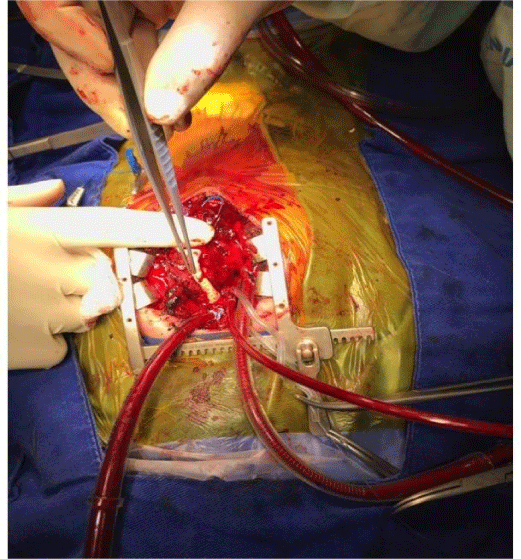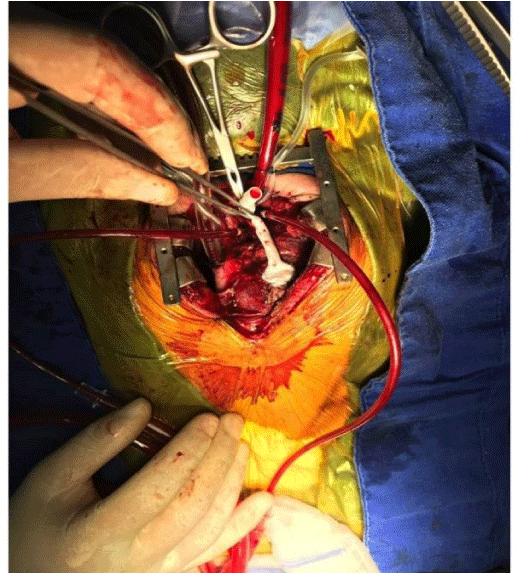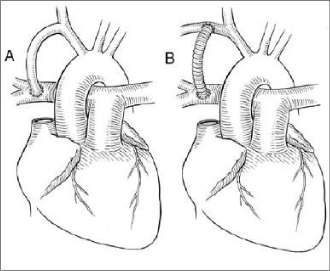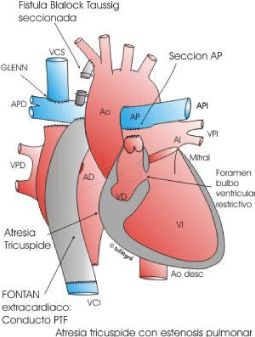International Journal of Vascular Surgery and Medicine
Clinical characteristics and prognostic factors of patients with cyanotic congenital cardiopathies that are taken to pulmonary system pulmonary of central type or modified Blalock Taussig, between January 2006 and June 2017: Retrospective multivariate analysis
Rios Giovanny1*, Molina German2, Correa Juan3, Díaz Carlos4 and Rojas Johanna5
2Fellow Cardiovascular Surgery, Hospital San Ignacio - Universidad Javeriana, Colombia
3Cardiovascular Surgeon, Hospital San Ignacio, Head of Cardiovascular Surgery Unit - Assistant Professor, Faculty of Medicine, Universidad Javeriana, Colombia
4Resident of General Surgery, Hospital San Ignacio - Universidad Javeriana, Colombia
5Head of Nursing, Cardiovascular Surgery Unit Hospital San Ignacio, Colombia
Cite this as
Giovanny R, German M, Juan C, Carlos D, Johanna R (2019) Recanalization of long iliac occlusions by humeral and radial approach- About 30 cases. Int J Vasc Surg Med 5(1): 009-013. DOI: 10.17352/2455-5452.000034Overall objective: Identify the more important variables that determine the prognosis and survival of patients with cyanotic heart disease who that underwent to pulmonary systemic fistula in San Ignacio Hospital between January 2006 and June 2017.
Methods: The database of the Cardiovascular Surgery service of the San Ignacio Hospital was reviewed from January 2006 to June 2017. From this registry, the information of the identity documents of the patients to be included in the study was obtained, in order to obtain the data of the variables to be studied from the electronic medical record of the San Ignacio Hospital.
We reviewed the clinical histories of pediatric patients with cyanosis cardiopathies who were taken to pulmonary systemic fistula between January 2006 and June 2017.
Results: The indications for the pulmonary systemic fistula were: 11 patients with pulmonary atresia with an integral septum, 10 patients with pulmonary stenosis, 6 patients with pulmonary atresia with VSD, 8 patients with pulmonary valve atresia, 1 extreme Fallot, 1 single ventricle. 51% of the patients were male, the average weight was 3408 gr (DE 1406, minimum weight 1735, maximum 8700), Average age 37.1 days (SD 74.8). A total of 17 Blalock - Taussig fistulas and 20 centrals were made. The average preoperative PH was 7.36 (SD 0.98). The 30 - day mortality was 37% of which 5 cases were Blalock - Taussig type fistulas and 9 central ones, there were no statistically significant differences in the U Mann Whitney test when comparing mortality by presurgical pH or weight.
Conclusions: Congenital cyanotic heart diseases are entities that require urgent treatment and in which definitive repair may not be possible, with a requirement for pulmonary systemic fistula creation in a palliative manner. Although different variables have been identified in the literature as prognostic factors for morbidity and mortality, the majority are non-modifiable such as the type of pathology, the preoperative weight, the diameter of the shunt and the need for preoperative mechanical ventilation.
Introduction
Congenital heart disease is a common group in malformations of birth. They are structural abnormalities of the heart or large vessels, which cause hemodynamic repercussions compromising the patient’s life. These defects are the result of alterations that occur during cardiac embryogenesis.
Worldwide, 4 million children die each year in the neonatal period, 7% of deaths secondary to congenital heart disease, a prevalence of 0.5 to 9 per 1000 live births is estimated [1], in Latin America the presence of Congenital heart disease is 2.6 per 10,000 births, in Colombia a prevalence of 15.73 per 10,000 births has been described between 2001 and 2008 [2].
The impact in Colombia of congenital anomalies has increased, reaching 2 places with respect to the causes of death in children under one year of age, with a mortality of 0.12 per 10,000 live births.
Congenital cyanotic heart disease with decreased pulmonary flow may be associated with a spectrum of abnormalities of the tricuspid valve, right ventricle, pulmonary valve, or pulmonary arteries.
The concept of improving systemic oxygen saturation and optimizing pulmonary blood flow by creating a short circuit between a systemic and a pulmonary artery in patients with congenital cyanotic heart disease, was introduced by Alfred Blalock who in 1945 successfully performed the first palliative surgery in a infant with pulmonary stenosis.
Six months later, together with Dr. Helen Taussig, a series of cases were presented, with which this technique was proposed as a treatment for congenital cyanotic heart disease [3].
In 1962 Waterson described a technique consisting of an anastomosis between the ascending aorta and the right pulmonary artery. The use of prosthetic material for the construction of pulmonary systemic short circuits was reported by Redo and Ecker in 1963 (Figure 1,2).
In 1970, a modification was proposed to the technique established by Blalock - Taussig, using the interposition of a polytetrafluoroethylene graft between the subclavian artery and a branch of the pulmonary artery for the formation of the pulmonary systemic short circuit [4] (Figure 3).
The objective of pulmonary systemic fistulas is to provide an adequate pulmonary blood flow in congenital heart diseases, where pulmonary blood supply is restricted. The treatment should focus on eliminating cyanosis, optimizing right ventricular function, increase growing and development in patients with these pathologies, being bridging therapy to later perform the optimal and definitive correction of heart disease presented.
The impact of each intervention on the anatomical structures mentioned, as well as on systolic and diastolic right ventricular function, should be considered in detail in order to obtain adequate results. (Figure 4) Types of palliation.
Objective
Overall objective
To identify the more important variables that determine the prognosis and survival of patients with cyanotic heart disease that underwent to the formation of pulmonary systemic fistula in San Ignacio Hospital between 2006 and June 2017.
Specific objectives
• Describe the frequency of presentation of cyanotic heart diseases according to sociodemographic variables such as sex and age.
• Determine the factors of conversion of pulmonary systemic fistulas Blalock Taussig type to central
• Identify factors associated with infra and postoperative complications during hospitalization
• Determine the frequency of cyanotic heart disease intervened with pulmonary systemic fistula
• Establish 30-day postoperative mortality.
Methods
Definition of the method
It is an observational, descriptive, cohort study. The review of clinical histories from January 2006 to June 2017 of patients with cyanotic heart disease was performed retrospectively, determining: type of congenital heart disease, sex, age, management and surgical technique, complications, type of fistula used, type Grafting used, 30-day mortality.
Population under study
Patients with pediatric cyanotic cardiopathies, of both sexes, will be selected, who underwent a modified Blalock - Taussig systemic pulmonary fistula or central at the Cardiovascular Surgery Service of the San Ignacio University Hospital between January 2006 and June 2017.
Inclusion criteria
Pediatric patients treated at the San Ignacio Hospital, with a diagnosis of congenital heart disease, operated on with pulmonary systemic fistula, during the period between January 2006 and June 2017, admitted by the emergency department, or scheduled by external consultation.
Exclusion criteria
Clinical histories without adequate registry of the variables under study, patient with combined surgeries that required pulmonary systemic fistula.
Case definition
The case is understood as the presence of a pediatric patient of either sex with congenital cyanotic heart disease, who is diagnosed clinically and confirmed by echocardiography, with subsequent realization of systemic pulmonary fistula.
Variables
Sex, Weight, Age, hospital stay, 30-day mortality, 1-year mortality, ICU stay, congenital cyanotic diseases such as tricuspid atresia, pulmonary atresia, Ebstein, Fallot, pulmonary stenosis, type of fistula, type of graft and diameter, reintervention, Blalock-Taussig’s step to central, complications, final oxygen saturation, Glenn surgery, Glenn age, if they were taken to definitive Fontan surgery and what age at the time of surgery.
Data collection techniques:
Source of information: this is a primary source, since the data are obtained from clinical records, and patients are followed up through postoperative controls. The data will be obtained by the researchers through a format for collection.
Evaluation format
The data obtained are made from the Clinical History, retrospectively and prospectively. From there the researcher will review the case and organize the data.
Collection of the data: the data were collected between the months of June 2017 and September 2017. A detailed review was made by the researchers of the records of: statistics of the cardiovascular surgery service of the San Ignacio Hospital. From there, the cases classified as congenital cyanosis heart disease were taken according to the determined variables.
Control of Biases and Errors: we keep in mind the heterogeneous population bias, where the intrinsic characteristics of the patients such as race, cultural level, nutritional status, socioeconomic status, comorbidities cannot be controlled, since all the individuals who entered are taken with the condition to the institution. This bias must be assumed, and it must be taken into account that the objective of the study is only to describe. There is no sampling error, since it is a Cohort study, where the entire population has been selected. There is information bias, given that all data is taken from the stories, and there may be underreporting, however, it is attempted to corroborate and complement the information with the institutional database. In the measurement, absolute values recorded in the medical records were used as instruments on age in years, the presence of congenital cyanotic heart disease, the type of heart disease, the use of pulmonary systemic fistula, the type of graft used, the evolution and complications , with a single meter which decreases the risk of error. Finally in the observation and analysis of data there is a bias to be the observer the same data collector, however this is decreased with an objective collection of data according to the clinical history and take into account that they are events that have already passed and that therefore they are not susceptible of modification.
Analysis plan
An univariate analysis of the different variables was carried out as follows:
- Quantitative variables: through measures of central tendency and dispersion.
- Qualitative variables: by means of relative frequencies (percentages) and proportions.
- The EXCEL ® program (© 2016 Microsoft) was used for the organization of variables and calculation of proportions and percentages and the STATA program (© Copyright 1996-2016 Stata Corp) for univariate and multivariate analysis with nonparametric hypothesis testing for comparison of independent groups.
Results
During the period between January 2006 and June 2017, 41 pulmonary systemic fistulas were performed, of which two were excluded from the study due to missing data and two to be performed with another procedure. The indications for the pulmonary systemic fistula were: 11 patients with pulmonary atresia with an integral septum, 10 patients with pulmonary stenosis, 6 patients with pulmonary atresia with VSD, 8 patients with pulmonary valve atresia, 1 extreme Fallot, 1 single ventricle.
51% of the patients were male, the average weight was 3408 gr (DE 1406, minimum weight 1735, maximum 8700), Average age 37.1 days (SD 74.8). A total of 17 Blalock - Taussig fistulas and 20 central ones were used, grafts with diameter of 22 of 4mm, 12 of 3.5mm and 3 of 5mm were used. The average preoperative PH was 7.36 (SD 0.98).
The reintervention rate was 27% of which 80% was due to occlusion (3 died) and 50% of the total of the reoperations was converted from Blalock - Taussig to central fistula. A trend of lower weight was observed in patients who required Blalock - Taussig conversion to central with a median of 2895 gr vs 3107 gr, however this difference was not statistically significant. The 30-day mortality was 35% of which 5 cases were Blalock-Taussig type fistulas and 9 central ones, there were no statistically significant differences in the U Mann Whitney test when comparing mortality by pre-surgical PH or weight. The distribution of mortality by pathology was: 5 cases of atresia of the pulmonary valve, 4 of pulmonary atresia with integral septum, 2 cases of pulmonary atresia with VSD and 3 cases of pulmonary stenosis.
Discussion
The creation of systemic fistulas lungs is a procedure that is associated with a high postoperative mortality and this in relation to variables such as graft diameter, pre-surgical PH, weight of the patient, in our cohort of 37 patients the mortality described was greater than that reported for patients with RACHS 1 (risk 3) (Risk Adjustment in Congenital Heart Surgery) which predicts a mortality at <30 days of 20.3% [5].
Although the literature reports risk factors for mortality and morbidity such as low preoperative PH, low weight and low graft diameter [6-8], in our cohort we did not obtain statistically significant differences with respect to mortality and morbidity compared with these variables, However, a trend in lower presurgical weight was identified in patients who presented thrombosis of the fistula.
The limitations of our study are the retrospective nature, however the data collected is reliable due to the availability of electronic records of medical records. Additionally, the low number of patients does not allow the identification of differences or risk factors for morbidity and mortality outcomes.
Conclusions
Congenital cyanotic heart diseases are entities that require urgent treatment and in which definitive repair may not be possible, with a requirement for pulmonary systemic fistula creation in a palliative manner. Although different variables have been identified in the literature as prognostic factors for morbidity and mortality, the majority are non-modifiable such as the type of pathology, the preoperative weight, the diameter of the shunt and the need for preoperative mechanical ventilation.
Ethical considerations
In accordance with the provisions of Resolution No. 008430 of 1993 of the Ministry of Health of the Republic of Colombia (Scientific, technical and administrative standards for health research), this is a risk-free investigation (no interventions or intentional modification will be carried out) in biological and psychosocial variables and sensitive data of research subjects will not be identified or treated), so it does not require the request of informed consent or authorization of patients whose stories will be reviewed.
The clinical data of patients are protected by medical secrecy. Authorization is requested to the Scientific Sub-Directorate of HUSI and to the Archive of Clinical Histories of HUSI to make the revision of the list of the localized clinical histories for the extraction of the necessary clinical data.
- Sandoval N (2015) Cardiopatías congénitas en Colombia y el mundo. Rev Colomb Cardiol 22: 1-2. Link: http://bit.ly/2Z9I0Xj
- Zarante I, Franco L, López C, Fernández N (2010) Frecuencia de malformaciones congénitas: evaluación y pronóstico de 52.744 nacimientos en tres ciudades colombianas. Biomédica 30: 65-71. Link: http://bit.ly/32Njfm7
- Rivera-Kinkel C (2010) Actualidades en el tratamiento quirúrgico de las cadiopatías congénitas. Rev Mex Pediatr 77: 214-223. Link: http://bit.ly/30RN2bj
- Kiran U, Aggarwal S, Choudhary A, Uma B, Kapoor PM (2017) The blalock and taussig shunt revisited. Ann Card Anaesth 20: 323-330. Link: http://bit.ly/2MaABU2
- Calderon J, Ramirez S, Cervantes J (2008) Meétodos de estratificación de riesgo en la cirugía de cardiopatías congénitas. Archivos de cardioligía de mexico, Vol 778 enero- marzo 60-76. Link: http://bit.ly/2JKGp4W
- Myers J, Ghanayem N, Cao Y, Simpson P, Trapp K, et al. (2014) Outcomes of systemic to pulmonary artery shunts in patients weighing less than 3 kg: Analysis of shunt type, size, and surgical approach. J Thorac Cardiovasc Surg 147: 672-677. Link: http://bit.ly/2Z8QCh1
- Kucuk M, Özdemir R, Karaçelik M, Doksöz Ö, Karadeniz C, et al. (2016) Risk Factors for Thrombosis, Overshunting and Death in Infants after Modified Blalock-Taussig Shunt. Acta Cardiol Sin 32: 337-342. Link: http://bit.ly/2XXCeM1
- Aguilar P, Lazo C, Rodriguez L, Marquez H, Gimenez J (2014) Factores relacionados con mortalidad en pacientes pediátricos con derivación de Blalock-Taussig. Rev Med Inst Mex Seguro Soc 52: S62-67. Link: http://bit.ly/2y8LvRU
Article Alerts
Subscribe to our articles alerts and stay tuned.
 This work is licensed under a Creative Commons Attribution 4.0 International License.
This work is licensed under a Creative Commons Attribution 4.0 International License.





 Save to Mendeley
Save to Mendeley
